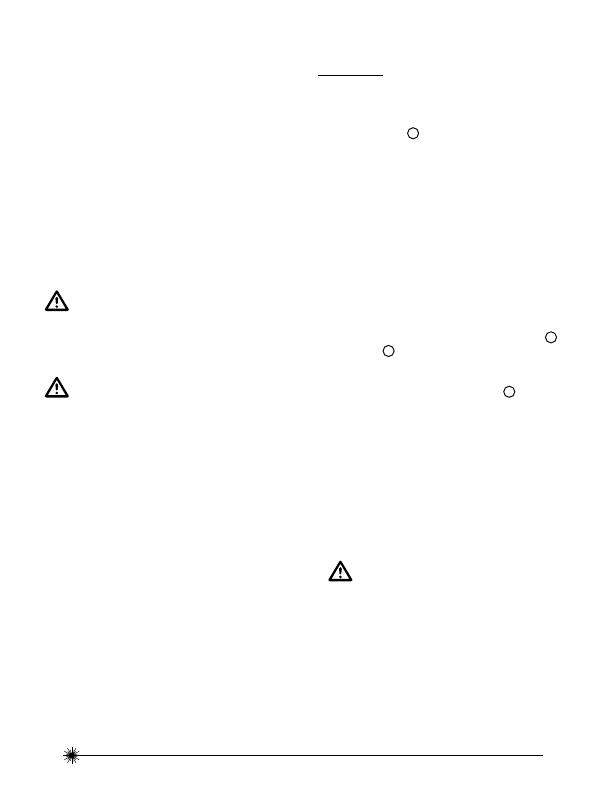
10
77-322
Charging Battery
• For best life, the rechargeable battery must be charged for
4 hours before fi rst use.
• Plug charging / power adapter plug into charging jack of
laser tool
• Plug charging / power adapter into power outlet (110 V or
220 V) with appropriate plug receptacle.
• The LED on the charging / power adapter will light RED
during charge.
• Leave battery to charge for approximately 4 hours to reach
full charge.
• When battery is fully charged unplug the charging / power
adapter from laser tool and power outlet.
• The LED on the charging / power adapter will light GREEN
when charge is complete.
WARNING:
• Use charging / power adapter only with Ni-MH
battery pack supplied. Charging any other
type of battery may result in damage and/or
personal harm.
WARNING:
• The battery and charging / power adapter can be
damaged if damp. Always store and charge the
tool in a dry and covered place.
NOTE:
• For best battery life, it is recommended to charge the
battery once it has been fully discharged and avoid letting
charge for > 10 hours at a time.
Operating with Charging / Power
Adapter
• Laser tool can operate while plugged into charging / power
adapter.
• Functions and controls of laser tool are the same as when
not plugged into charging / power adapter.
Set Up
Mounting on Accessories
Legs (See fi gure
D
)
• The legs on the laser tool can be removed to allow the
laser tool to be directly placed on a surface and / or
accessory.
• Remove leg base screw to release the leg base from
the main laser tool.
• If attaching the laser tool to an accessory, re-insert
the leg base screw into the laser tool to connect to a
5/8 center screw thread.
• To attach the leg base to the laser tool:
• Remove the leg base screw, if it is on the laser tool.
• Place the leg base screw up through the center hole
in the leg base attachment.
• For easy reference, position the leg base in such
a way that the circular bubble is above one of
the adjustable legs as shown (See Figures
D
and
A
).
• Tighten the leg base screw.
Tripod / Accessory Mount (See fi gure
E
)
• Position a tripod / accessory in a place where it will not
be easily disturbed and near the central location of the
area to be measured.
• Set up the tripod / accessory as required. Adjust
positioning to be sure tripod head / accessory mounting
base is near horizontal.
• Remove the leg base attachment from the laser tool, as
instructed above, for easier mounting.
• Mount the laser tool to the tripod / accessory by pushing
up the 5/8 center screw and tighten (An adapter will be
required for accessories with 1/4 thread screw).
CAUTION:
• Do not leave the laser tool unattended on an
accessory without fully tightening the center
screw. Failing to do so may lead to the laser tool
falling and sustaining possible damage.
NOTE:
• It is best practice to always support laser tool with
one hand when placing or removing laser tool from an
accessory.
• If positioning over a target, partially tighten the center
screw, align laser tool, and then fully tighten.








